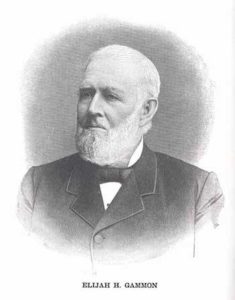
Elijah H. Gammon
*This date celebrates the birth of Elijah H. Gammon, who was born in 1819 and was a white-American minister, businessman, and abolitionist.
Born in Maine, he grew up on a farm. He was converted (in faith) at seventeen, became a school teacher at nineteen, and entered the ministry of the Methodist Episcopal Church at twenty-four. His health deteriorated, and he moved to Illinois, where, in 1858, he had to give up preaching. He recuperated and changed careers to the manufacture of harvesting machinery. With this vision, he earned a fortune and substantially contributed to the development of harvesting machinery. Gammon's business responsibilities and success’ did not limit his spiritual vision.
He had little desire to accumulate money for purely selfish ends. A mutual friend brought Mr. Gammon and Bishop Henry W. Warren together. Bishop Warren, who had been living in Atlanta, Georgia, on the campus of Clark University, had become deeply impressed with the need for a school to train Black ministers. Gammon, who had been actively interested in the welfare of the Blacks, was looking for a place to invest some money where it would do the most good. In the black community, as he had seen in the vast harvests of the West, he saw great undeveloped resources.
The plan was to establish a chair of theology at Clark University, and in 1882, Gammon gave $20,000 for the endowment of this chair. Clark announced the new department, listing Professor W. H. Crogman as the Professor of New Testament Exegesis, and that a Dean and Professor of Systematic Theology would be secured for the fall. The school opened on October 3, 1883; the new Dean was the Rev. W. P. Thirkield, who remained there for seventeen years. Nineteen pupils were received in the first year. In 1888, the school was separated from Clark and was given the name Gammon School of Theology, which eventually changed to Gammon Theological Seminary. At this time, Gammon turned over $200,000 to the school to be used for endowment.
Gradually, the seminary became his chief interest. Homes for the professors, a library, and other buildings were added to the main building. When Gammon died, he made the seminary a legatee to one-half the residuary portion of his estate. This brought the endowment of the seminary up to half a million dollars. Gammon's aspiration for the school was summed up in a letter written in 1887, in which he said: "I would like to see it as the best theological school in the whole south, white or black." The last five months of Mr. Gammon's life were spent on the Gammon campus. Elijah H. Gammon died in 1891.
Today, Gammon Theological Seminary occupies a beautiful campus of seventeen and a half acres just within the southern limits of Atlanta; Clark University, adjoining, is outside the city. The land is high, rolling, and covered with a beautiful grove of pine and oak trees. The buildings overlook the city. On the campus are the main building, Gammon Hall, a lovely and well-appointed library, a modern refectory for the students, five excellent residences for professors, and ten cottages for married students. The whole forms a well-nigh ideal spot for study.
Clark Atlanta University
223 James P. Brawley Drive, SW
Atlanta, GA 30314